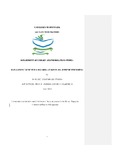Management of business records at Botswana Supreme Furnishers
Date
2016-07-15Author
Moatshe, Boniface
Link
UnpublishedType
Masters Thesis/DissertationMetadata
Show full item recordAbstract
This study examined management of business records at Supreme Furnishers in Botswana and
recommends strategies for managing them for easy access and preservation in future. The objective of the study was to determine the company’s level of compliance to legislative and regulatory framework (ISO, policies and procedures) of managing business records in Botswana; determine the nature of records created and retained at Supreme Furnishers; examine the resources available in managing records at Supreme Furnishers; establish the challenges encountered in handling records at Supreme Furnishers; and propose solutions aimed at improving records keeping at Supreme Furnishers.
The respondents in this research study were employees of Supreme Furnishers. These respondents included Regional Managers, Business Managers, Credit Managers, Credit people, Sales people, Cashiers and Stock Controllers. This survey was informed by the Hybrid model (a combination of the Record Life Cycle and Record Continuum models). A combination of data collection instruments were used, namely, questionnaire, interviews and personal observations. In this regard, about 40 questionnaires were administered and 35 were successfully filled and returned. SPSS was used to analyse the data obtained from these instruments. Furthermore, quantitative and qualitative data collection approaches were also employed.
The key findings of the study revealed that majority (68.6%) of Supreme Furnishers employees were not aware of Botswana Company’s Act 2008: Chapter 42:01, section 218, which requires keeping certain company records. Nonetheless, the organisation complied with the Hire Purchase and the Income Tax and VAT Acts, although some departments in the organisation did not comply with them. It was further discovered that Supreme Furnishers was not guided by ISO 15489:2001 in managing its records. Instead internal procedures such as classifying records, particularly invoices according to dates were employed. Stock records were also classified alphabetically. There were shortages of records management resources mainly, records storage spaces and equipment such as cabinets, boxes and shelves. The study further revealed that there were no classification schemes and file tracking systems in the organisation. Besides, Supreme Furnishers did not have either a records management policy or a records management Committee.
This study therefore recommends that Supreme Furnishers should employ best records management practices by complying with the legislation especially Companies’ Act and records management international standards. The study further recommends that Supreme Furnishers should establish a records management policy, an access policy as well as a records management committee. This study further concludes that the records management programme will function effectively and efficiently if it is developed as part of the strategic management of the organisation. It will enable Supreme Furnishers to have a competitive advantage over its competitors if it is considered as an organizational asset.

